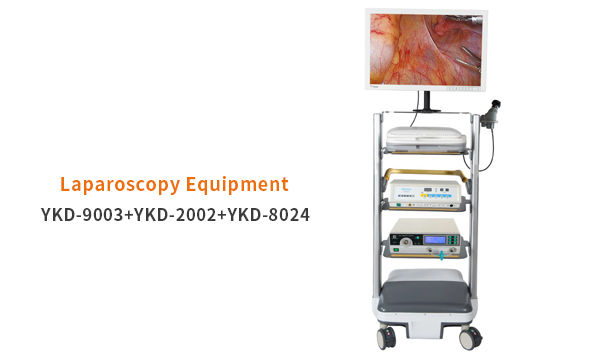Laparoscopic surgery equipment usually consists of the following 5 parts:
1. Display camera system, including monitor, endoscope camera host, laparoscope, signal converter, its function is to collect and display clear and realistic images in the body cavity;
2. Cold light source system, whose function is to provide lighting for surgery;
3. Pneumoperitoneum, its function is to provide enough space for surgery;
4. High-frequency electrosurgical unit, including single-stage and bipolar, whose function is to implement resection targets;
5. Negative pressure suction system, including suction tube, suction pipe, and suction bottle, whose function is to attract the resection and the tissue fluid flowing out during the operation;

Common faults and troubleshooting methods of laparoscopic equipment during operation:
1. Display camera system failure
(1) Black screen phenomenon: The display, cold light source system power connector, camera line connector falling off, poor contact and damage to the cold light source system bulb, etc., will cause the display to black screen. Therefore, the equipment should be carefully inspected before the operation, and replacement bulbs for the cold light source system should be always available.
(2) The image is not clear: the camera focal length is too high or the lens is contaminated with foreign matter can cause the image to be unclear, fine-tuning the focal length or wiping the lens with an iodophor cotton swab can solve this problem.
(3) Imbalance of image brightness: During the operation, the light in the operating room should not be too bright, the shadowless light should be turned off, and the cold light source should be adjusted to the automatic position, otherwise it will cause the image to be too bright. The dark image may be caused by two conditions: ①The connection between the cold light source guide light beam and the laparoscope is loose or the cold light source connection is slightly loose. As long as the connector is pushed forward a little, the light source can be restored to normal; ②Illumination fiber part Broken wires can be solved by replacing all the lighting fibers.
(4) Image color imbalance: The wrong setting of the camera's white balance will cause image color distortion, so you need to automatically or manually set the white balance before using the camera system.
(5) Fog vision: preheating is required before inserting into the abdominal cavity through the cannula to make the temperature exceed the temperature of the human abdominal cavity to avoid fog vision. Place the laparoscope in normal saline at 40°C for about 5 minutes. can.
2.Pneumoperitoneum failure:
(1) Pneumoperitoneum needle blockage: The pneumoperitoneum needle can be blocked by fat particles, blood clots or other tissue fragments during the operation. The treatment measures are to use a 5ml syringe to suck saline and flush it smoothly. Sometimes the pneumoperitoneum needle piercing the peritoneum can also cause the pneumoperitoneum needle to be blocked. At this time, the pneumoperitoneum needle needs to be removed and reinserted into the abdominal cavity.
(2) Pneumoperitoneal muscle pressure is too low: Moderate CO2 gas pressure is necessary to maintain abdominal pressure and create a visual environment that is conducive to surgical operations. However, once air leakage occurs, the pressure of the pneumoperitoneum will be too low, and then It is difficult to maintain the pressure in the abdominal cavity. Many factors can cause the pressure of the pneumo-abdominal muscle to be too low. The common ones are air leakage caused by the loosening of the gas pipeline joint and the damage of the trocar sealing cap. The wrong setting of the CO2 pressure parameter cannot be ignored. Under the correct CO2 pressure parameter setting, tightening the gas pipeline joint and replacing the damaged trocar sealing cap in time is the basic prerequisite for maintaining the normal level of the pneumoabdominal muscle pressure.
3.High-frequency electric knife failure:
(1) Single-stage electric knife failure: The loose connection of the electric knife, the coagulation wire and the host will cause the two to have no output. Check the connectors of the two in time and connect them to the host firmly. When the negative pole of the electrosurgical main unit is in poor contact with the port of the main unit, the electric cutting and electrocoagulation will stop working. The indicator light of the negative plate turns from green to red and an alarm is issued. Excessive dander in middle patients will cause poor electrosurgical circuit. It is necessary to remove the dander on the skin surface before surgery. More fur will also cause the same effect. It is necessary to keep the skin smooth.
(2) Bipolar electrosurgical failure: Bipolar condensation failure is usually caused by poor contact between the bipolar line and the host. You need to adjust the contact surface of the two or replace with a new bipolar line. Excessive scabs of the product during blood coagulation will cause bipolar line coagulation failure, and it must be cleared and cleaned in time.
4.Negative pressure suction system failure
(1) The system has no negative pressure or small suction: the closure of the central negative pressure, the disconnection of the suction pipe and the sealing of the suction bottle can cause the system to have no negative pressure or small suction. Once found, it needs to be checked quickly.
(2) System blockage: After the operation, the suction system must be repeatedly flushed with high-pressure air and double guns, otherwise the blood clots will dry and scab or other foreign bodies will silt up and block the suction system in the lumen. In addition, the suction system will not be used for a long time. It needs to run for a period of time on a regular basis to ensure the normal operation of the machine.